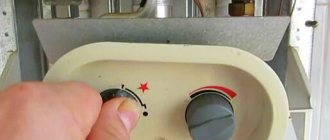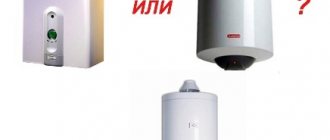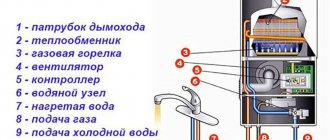The main reason why a geyser goes out: there is no draft in the room or it is extremely low to maintain the normal operation of the device. Most often this happens because in the room where the speaker is located, the window or door is tightly closed. The device is designed in such a way that it has a special relay for thermal protection against overheating, and in the absence of traction, the device heats up excessively and then turns off. Try to provide air flow into the room and light the column. If the device does not go off within ten to fifteen minutes, then you can be sure that the problem is poor draft.
Another equally common cause is a chimney clogged with substances resulting from combustion, or some foreign object
. Special sensors in the Neva device detect this, and the gas water heater does not ignite. How to check if there is draft in the chimney? It is enough to open a window or window and let a stream of air into the room and place your hand next to the chimney outlet. If you feel even a slight whiff, the chimney is not clogged. Otherwise, you need to take care of cleaning the chimney as well as the ventilation duct.
Another reason why a geyser goes out and does not light up again is that the elements powering it may have discharged
. This problem is typical for devices that are equipped with systems for automatically turning on or off. Simply replace the supply batteries or generators and check the operation of the on/off key.
Checking the water supply
Features of the speakers
with an automatic protection system is that, regardless of whether water is supplied or not supplied to the unit, the flame in the igniter must burn without interruption. The gas supply should be stopped only after any of the elements in the protection (solenoid valve, thermocouple or thermal fuse) are activated, the igniter becomes clogged or the thermocouple breaks.
It is very easy to understand that at least one of the protection elements is not working. As soon as you stop holding the knob to adjust the gas supply
, the flame in the igniter goes out.
Automatic protection system
Diagnostics and repair of thermal fuse
To make sure that your thermal fuse is not working and that it is the cause of the malfunction, short-circuit its terminals
any metal object, such as a paper clip. If at the same time your geyser stops turning off, then the problem is in the thermal fuse, which will need to be replaced.
Diagnostics of the performance of the solenoid valve and thermocouple
If you are sure that the thermal fuse on your gas water heater is working
, you need to test the solenoid valve. You must make sure that it gives a resistance of 0.2 ohms. You will need to apply a current of one hundred milliamps and a voltage of twenty to thirty millivolts to the coil. To carry out such a test, you only need a resistor rated for 100 m and a AA battery.
Applying current, start the gas into the igniter
, then light the wick and remove your hand from the ignition button and gas control knob. During this diagnostic, the gas should burn continuously, but as soon as you disconnect the battery from the valve, the gas supply should stop. If the diagnostics were carried out as described above in the text, then we can conclude that the solenoid valve is working properly, so in this case the thermocouple of the gas column, which needs to be replaced, does not work.
Igniter problems and their elimination
Most often, gas burns poorly and goes out due to the fact that the nozzles in the igniter are heavily clogged with soot and soot.
. The danger here is that gas begins to accumulate in the igniter, and sooner or later an explosion may occur. To prevent this from happening, you need to clean the igniter.
When there is not enough oxygen in the combustible mixture, the flame acquires a characteristic yellowish tint.
instead of blue. The problem lies in the igniter hole, which is responsible for the oxygen supply, clogged with dirt.
To eliminate the problem, you need to unscrew and remove the igniter. Since in different models of geysers, for example, junkers, Bosch or Neva, the igniters are attached to the columns differently, it is impossible to give one general sequence of actions for removing the igniter. Look in the instruction manual for your gas water heater to see how best to do this, and then clean the nozzles and oxygen supply holes using a thin wire.
__________________________________________________________________________
Answers from users on repairing the Junkers geyser
Question: I have a Junkers WR-10 gas water heater installed and it takes a very long time to tinker with its ignition. Piezo ignition. At first you have to hold the button for a long time (about a minute). Then the piezo igniter somehow does not ignite it (rarely). Well, it doesn’t bother me anymore - we’re used to it. We light it with a match - after holding the button for a minute and a half (apparently so that the gas accumulates). Then, when the wick is still lit, hold the button for about a minute and only then move it to the right. Tell me what could be wrong. It's very difficult to light it.
Answer: The reason is simple - gas comes out of the tube. Therefore, until the tube is filled with gas, the wick does not burn (described in the manual). This column should operate in standby mode on wick. If you're worried about the wick constantly burning, buy an automatic one.
Question: The wick lights up, I keep it in this position for 5 minutes, switch it to working condition, it goes out. Gas water heater Junkers Bosch semi-automatic! Why is this so, what should I do?
Answer: I had the same problem. I removed the housing, disconnected the tube through which gas is supplied to the wick, and blew it out with a pump from the bicycle. put it back - everything works! as one speaker repairman explained to me, this needs to be done once a year, especially after the summer, when the windows are open and dust, etc. gets clogged up in this tube.
Question: We installed and started up a Junkers gas water heater and the problem is constant in winter. There is also not enough gas, and besides, the gas that is often supplied is not pure. But it’s European, they don’t understand what red gas is instead of blue.
Answer: on your column at the bottom there is a screw under a seal (blue plastic). You remove it and, with the burner on, turn it counterclockwise within reason (you will see it by the flame). You'll be back for the summer. If this doesn't help, the pressure may actually be low.
Question: I use a Junkers WR-275 gas water heater in my house. Over the course of 10 years, two columns of the specified company and brand failed. I didn’t clean the first one at all - it worked for 5 years and the heat exchanger leaked. The repair resolved the issue for 3 months and a new one was purchased. The installer said that the whole problem was that he did not do maintenance (cleaning). So I cleaned the new one. Result: I worked for 4 years. The reason for the failure is the same - the heat exchanger. Why is this happening?
Answer: You simply have a problem with water quality. Because of this, heat exchangers fly.
Question: after the column has been running for 2-3 minutes, it turns off completely, after which the wick can only be lit with matches. Does anyone know what to do with Junkers?
Answer: There was such a problem, they changed the water overheating sensor. Everything works well.
Question: The Junkers burner worked for 7 years. The igniter does not work. and if you light it with matches, the wick goes out when moved to the working position. what can you recommend?
Answer: I have the same problem. The technician said that the thermocouple had burned out.
Question: Column Bosch Junkers WR-13-2. Installed two years ago. From the very beginning there were problems. The first time I couldn’t light it for about half an hour. Something was stuck there and the column did not want to light up. Then something clicked and it seemed to start working. And so it worked for two years, igniting every other time. And now I’m starting to get really weird. The display shows a temperature of 40 degrees, and the water flows a little warm. You increase the temperature with your hands to normal to wash, and the display shows 62 degrees!
Answer: The thermometer there has no connection with the gas supply and burner power. It's just a thermometer. Well, this what’s-its-name generator. With our water and its pressure, this is often a useless device. And sometimes it works, but there is not enough power, especially during ignition, since at this time the maximum current is consumed. Treatment is switching to batteries.
Checked, the symptoms are exactly the same - ignition every other time, puffing, etc. since the spark is weak and cannot ignite the burner. At a minimum, for starters, connect the power from two new R20 alkaline batteries in parallel (without mixing up the polarity, red is positive, and the connection should be 1.5V, not 3). Regarding the thermometer - if it is lying too much - most likely the temperature sensor has gone sour, replace it.
Question: please tell me the electronic unit of Junkers gas water heaters, why might it fail? Explanations from the service technician due to power surges in the network. I don’t understand something, the speaker is not connected to the network. Who has encountered this?
Answer: We will try to help you. The house is equipped with a Junkers WR-10 B gas water heater. The water heater did not work for even a year and suffered its first failure - the burner stopped turning on (but the igniter did light up). The reason is a breakdown of field-effect transistor Q2 in the electronic control unit (without it, the circuit does not sense the burning igniter and does not want to open the burner valve).
I replaced the broken transistor with a KP303V (KP303B should also work). It turned out great, but a month later it was rejected again. I replaced the transistor again, but it barely lasted a couple of months. Having replaced the transistor (Q2) for the third time, I bypassed its gate circuit with a varistor of type 390KD07 (39V), i.e. added a new component to the circuit. This protection turned out to be sufficient - the speaker has found a new life and has been happy for 3 years!
Question: A Junkers WR-13-P gas water heater with piezo ignition is connected. We bought it in January 2008, that is, it is not even a year old. It worked without any complaints. We were very pleased. This afternoon the column simply turned off (the flame went out). Trying to light it again was unsuccessful; I can’t even light the igniter. I checked the hood and everything was fine (I thought the hood control sensor was cutting off gas), the gas pressure was also normal. The question is: What could be the matter? Has anyone encountered such a problem?
Answer: Try cleaning the igniter. Perhaps you need to check all contacts: on the thermocouple, overheat sensor.
Question: Gas. Column Junkers WR 13-P, installed about 4 years ago, used little, sometimes did not turn on for several months (due to departures), a year ago, began to go out periodically, then did not light up at all (when you release the button, the igniter goes out), they called a technician from the service center, he came and rubbed sandpaper over the thermocouple several times - everything worked. Three minutes, and not such a cheap call. Six months later, the same story again, the igniter goes out as soon as I release the button, I, like a master, periodically cleaned the thermocouple with fine sandpaper, at the very least it worked.
But now nothing helps, the igniter tube is clean, the heater is not clogged (the pressure is normal), the overheating and draft sensors seem to be normal, there is draft. Apparently the problem is in the thermocouple, I called to find out about the money and the work, the cost is half a new column. A little expensive. Does it make sense to change or buy a new one? Is it generally possible to somehow directly short-circuit, bypassing the thermocouple, or install a thermocouple from another, cheaper brand?
Answer: Maybe my experience will be useful. Symptoms: The igniter does not light, if you manage to miraculously ignite the igniter, then the gas water heater works for a short time until the hot water is turned off for the first time (the igniter goes out again). One of the reasons: The igniter flame does not reach the thermocouple or reaches it, but is unstable. The igniter in a Junkers gas water heater is usually secured with two clamps. Over time, for one reason or another, the igniter tube becomes displaced (when trying to clean it, igniting it with matches (and probably everyone has tried this), or in the “hearts” - they tapped the tube with something).
If you pay attention, you will see that the tube is not rigidly attached to the gas outlet from the column. Try adjusting the gap between the gas supply hole in the tube and the igniter tube itself, so that air enters the tube along with the gas and draft appears. You will immediately see that the flame from the igniter will lengthen and “lie” more horizontally and will reach the thermocouple. And the wick will light up more stable from the piezo spark.
Question: Can you tell me where the Junkers WR-275-1 geyser can have water pressure adjustment? The instructions only describe adjusting the gas pressure (screw under the sealed lid), but nothing is written about water. I suspect the healthy screw is at the very bottom of the block, but I would like to clarify.
Answer: This means there is no water pressure adjustment. On such columns, only a flow regulator is installed - a large knob on the front panel. But for real pressure regulation you need a reducer - they are not installed in columns.
Question: Column Junkers WR 275-1, everything worked fine before. It hasn’t been used for about a year, and now the gas doesn’t turn on when you turn on the water (the ignition is still on). Please advise what can be adjusted there?
Answer: The rod is soured or the membrane of the hydraulic flow sensor is torn. The gas regulator may be in the “Ignition” position. If the former, then try to disassemble and check the rod and membrane. The hydraulic unit is located at the water inlet to the column. This is a large flat round frog to which two pipes are screwed - from the cold water inlet and a tube going to the heat exchanger. It is necessary to unscrew both water tubes and remove the assembly.
As a rule, it is fixed with 2-3 screws. After removing the assembly, you will see a thin rod that presses on the gas control valve. Once you disassemble the unit, you will immediately understand its design. Just remember the position in which the membrane is placed. Inspect the membrane for tears. If the membrane is damaged, then only replace the membrane, but this is very rare. It is best to lubricate the rod with a greasy, water-resistant lubricant. You can disassemble the hydraulic unit as much as you like, but don’t get into the gas part. The malfunction is standard, it can be treated quickly and without problems.
Question: There is the following problem with the Junkers WR 275 gas water heater. To start the water heater, you need to turn on the hot water at full blast, reducing the pressure - the water heater goes out. I monitored the reaction of the column to manipulation of the hot water tap - it reacts, but only in the upper position, that is, it is not possible to set a convenient low pressure; when washing dishes, for example, water scatters throughout the kitchen. It is not possible to measure the water pressure in the system; it is impossible to hold the water in the tap by turning it off with your finger (due to the pressure). Is it possible to somehow make the column react and turn on with less water pressure?
Answer: All speakers do not like to work on a small flow. If it worked fine before, but now it has become bad, then disassemble the frog and change the elongated membrane. At the same time, it is very useful to lubricate the rod with a fatty, water-resistant lubricant. This unit is responsible for turning the gas on/off.
Question: How can I turn down the gas supply when the water is very hot? The lamb is turned all the way down. Does not help.
Answer: There are two user adjustments on Junkers WR 275 geysers. The first is a lamb, which can be used to reduce the temperature at the outlet of the device by allowing part of the flow to bypass the Venturi. the second is the burner power control knob. It has three positions - burner off, ignition - minimum power, maximum power. If the water temperature is still hot when the flow regulator is fully open, move the burner power regulator to the minimum position; the temperature should drop. If not, then look for the gas supply adjusting screw. It's under an aluminum cap. It’s always like this for summer, but you’ll have to put it back for winter.
Question: Yesterday the gas heater went out when the hot water was turned on, I tried to light it, but it didn’t work. I put the slider in the center, click on it, click the piezo. The wick burns while I press the slider, as soon as I let go the wick goes out. I tried a hundred options, but the wick goes out. Tell me if anyone knows what the reason is?
Answer: the thermocouple is washed by the igniter flame; it must be completely in the flame. there is a blockage and the flame barely touches it, then such a defect is possible or the thermocouple itself is covered
Question: We use a Junkers gas water heater. If gas does not flow due to incorrect adjustment, how can I check/adjust it correctly?
Answer: There are two types of speakers: 1. With a constantly burning igniter. Everything is extremely simple there. I pressed the start button, the gas went only to the igniter, ignited it with a piezo ignition or a match, the igniter caught fire. Wait 10-15 seconds during which the gas control thermocouple warms up and you can release the start button. The igniter burns due to the flow of gas through a valve, the coil of which is powered by electricity from a thermocouple.
Keep in mind that there is a poor draft protective thermostat in series with this coil, located at the top of the column near the chimney connection point. The operating philosophy of all speakers is the same, regardless of manufacturer. In principle, speakers of this type can be repaired by any technically competent person. The main thing is not to climb into the gas part. It is, as a rule, eternal. All faults in these columns are in the plumbing or weak chimney draft.
2. Junkers geysers with automatic start. Everything is more complicated there. The gas ignition circuit is started by a signal from a microswitch, which is triggered by a water flow sensor. After this, the gas supply valve to the igniter opens, which supplies gas for about 15-20 seconds, and then turns off. Simultaneously with this valve, the ignition spark generator begins to operate. The control circuit begins to control the ignition of the igniter based on the ionization current (for this purpose, there is another electrode next to the ignition electrode).
There is no thermocouple there. If the ionization current does not appear within 15-20 seconds, then the supply of gas to the igniter and the generation of a spark will stop. Then everything will repeat only after closing/opening the water. When an ionization current appears (ignition of the pilot), the control circuit gives a signal to open the main gas valve, which opens gas to the burner.
There is a modulation unit in series with the burner, which regulates the gas supply depending on the water flow rate and the readings of the hot water temperature sensor. Often a power regulator (winter/summer mode) is installed in the gas path, which limits the power of the burner. Naturally, the gas supply stops when the low draft sensor is triggered or when the water flow stops.
__________________________________________________________________________
__________________________________________________________________________
_______________________________________________________________________________
The gas water heater in many apartments has long replaced the central heating network. The fact is that such a device is much more convenient. After all, thanks to it, you can regulate the temperature of warm water yourself, and you also have to pay much less for utilities. However, geysers also have their drawbacks, first of all, these are periodic malfunctions in the form of their unexpected extinguishing. Why such a problem can arise and how to deal with it - read on.
The principle of operation of the gas water heater
To better understand the reasons why a geyser may go out, you need to understand the operating principle of such a device. Only after studying the essence of the process of heating water with a similar device can you talk about its malfunctions.
There are many manufacturers producing geysers. These are the world-famous expensive Bosch and Zerten, and more budget analogues such as Oasis, Vector, Neva Lux 5514, Beretta, Avangard, Astra, Mora speakers. In any case, the basic operating principle of all the above models is the same. The only thing is that there are automatic and semi-automatic speakers, but the difference between them is insignificant.
Main elements of a gas water heater:
- A gas burner is one of the most important elements of a gas water heater.
- A heat exchanger is located above the gas burner. It is a tube bent into a spiral, flowing through which water is heated.
- The ignition device can be electronic, and ignite from a button, or have a pilot light or wick that never stops burning. Old gas water heaters had to be ignited with matches, but modern models have piezo ignition activated by pressing a button.
- The water-gas unit includes two components: a membrane and a gas valve. When the water is turned on, the membrane bends and opens the gas valve, thereby ensuring gas flow into the burner.
- The safety automation includes sensors and a solenoid valve. If there is any malfunction, the electromagnetic sensor closes the valve and the column turns off. The kit also includes a thermocouple, which is activated when the pilot burner is turned off.
Thus, there is no reservoir for storing water in geysers. Passing through the heat exchanger, the liquid heats up in a matter of seconds, thereby ensuring a constant supply of warm water to several water intake points at once.
Natural gas is used to heat water with a gas water heater. Such raw materials cost several times less than electricity, which reduces the popularity of geysers.
Knowing the structure of the gas water heater, you can understand why it goes out. We will describe to you the main problems and tell you what to do in this case.
When does the shower turn on?
If the water heater works properly while using the tap, and after turning on the shower turns off, this may indicate the following:
- The watering can is clogged. When switching to a watering can, the gas may go out as the water pressure drops. You can check this by unscrewing the watering can from the hose. If the water heater turns on, this is the reason. You should wash the watering can or replace it with a new one.
- The hose tube is tangled. Inside the iron shower hose there is a rubber tube, which, when turned, can partially or completely block the flow of water. It is necessary to test turning it in different directions.
- Small watering can. A watering can with a small flow can also interfere with the pressure. It needs to be replaced with a huge model. You can also open the hot water tap in the sink at the same time. This will increase the flow of water passing through the column, and it will start working.
- The mixer switch is broken. If the water heater works when you use the faucet in the bathroom, but turns off when you switch to the shower, the switch in the faucet may be broken. Perhaps a piece of rubber or a pebble got into the switching unit. Disassemble the faucet, clean it and change the gaskets.
- Filter clogged. At the entrance to the watering can there is a mesh filter, which should be cleaned from time to time or replaced with a new one.
READ How to remove a gas pipe in the kitchen
In order to avoid breakdowns, it is necessary to frequently carry out preventive maintenance: checking the chimney, cleaning the radiator, replacing filters and gaskets.
In addition, another reason and its solution can be viewed in the video below using the example of the Neva 4513 column:
During work
column lights up, works for a long time, and then turns off.
- Check the options. Perhaps you have chosen to automatically turn off after a certain time.
- Temperature rise - more than 100 degrees. Then the temperature detector is triggered and the work stops.
- Poor pressure in the water or gas pipeline.
- Lost contact between thermocouple and electric valve. Clean the contacts and tighten the connections.
- The power supply contacts have oxidized. With all this, the device clicks, but the wick does not glow. It is necessary to clean the contacts.
- The batteries are low. Replace every six months. It is better to take batteries that hold a charge longer.
Goes off immediately after switching on
If the device turns off immediately after startup, the ionization detector may have failed. It is responsible for the presence of a flame in the burner. How to realize that this is the problem:
- The burner goes out 3-5 seconds after ignition.
- Restarting is accompanied by longer-term operation.
- After a few starts, the equipment begins to work normally.
- After the “rest” the problems are repeated.
Inspect the wiring that leads from the sensor to the control board. If everything is in order, the part will need to be replaced.
The column lights up normally, but after a few minutes of operation it goes out. A sensor that reacts to combustion products has triggered. Perhaps a lot of them have accumulated and they are not being removed.
- The chimney is clogged with soot, soot, and debris. There is no ordinary traction, the work is not carried out. It is necessary to clean the chimney opening on its own side. If that doesn't help, call the utility company.
- There is powerful ventilation nearby. Then the waste is pulled into the ventilation hole. While the speaker is operating, turn off the ventilation or set it to the lowest power.
- The heat exchanger is clogged. When working, scale, soot, and soot are deposited on it. You will be able to see that the color of the flame changes: it becomes yellowish instead of blue. Remove the casing, unscrew the heat exchanger fasteners, and clean it. We wrote how to do this in the article “How to clean a gas water heater”.
- No ventilation. To have draft, natural ventilation is needed. Open the window or install the valve.
- Extinguishing when the ignition button is released. The problem is typical for equipment with piezo ignition. You must hold the button for more than 10 seconds.
How to check traction? Bring a flaming match to the control window or ventilation. If the flame deviates to the side, there is draft. If it stays burning evenly, no.
Goes off when mixed
When a hot flow mixes with a cool one, the pressure in the line drops. Therefore the wick goes out. Adjust the settings on the regulator to a comfortable temperature. Reduce the pressure using the special handle.
If you mix water, make sure that the hot stream remains the main one.
The gas heater goes out when you turn on the shower or very hot water comes out. Solution to the problem.
Reasons why the Oasis geyser lights up and goes out
When asking the question: “Why does the geyser go out?”, you must understand that there can be quite a few reasons. However, if such a problem occurs, do not rush to immediately contact a specialist; in some cases, you can cope with such a problem yourself.
Reasons why a geyser may go out:
- This problem can arise if the pipes are installed incorrectly;
- You also need to check the traction. If it is missing, then your chimney may be clogged. Because of this, combustion products may not be removed.
- If you smell gas, it is possible that a satellite dish is installed above the chimney, which is strictly prohibited by gas services.
- Does the speaker light up but turn off within a few minutes? Perhaps your relay is simply too sensitive.
- If the battery or battery is discharged, the automatic ignition column will not work.
- By the different water pressure in the bathroom and kitchen, you can judge that the Bosch Junkers brand column is faulty. If the pressure is equally weak at both water intake points, then the reason lies in the water supply network.
- The thermocouple automatically turns off when heating is poor. This problem can occur when there is a slanted and uneven flame.
Also, the condition of the column is affected by its operating time. If you are using an old device and are having problems with fire, then one of the components may have failed. In this case, you are unlikely to be able to do without the help of a specialist.
What other reasons are there for extinction?
Failure of the gas water heater can also be caused by these elements.
Outdated membrane
The polymer material from which the membranes are made has sufficient elasticity, but after many years of use it disappears and the element becomes rigid, and it is possible that cracks or lime deposits may appear in it. Such defects will not allow the gas water heater to work regardless of how the tap is opened. Therefore, it is worth removing and inspecting the membrane: if its condition causes concern, a replacement for this element should be found as soon as possible.
Ignition system and piezo element
In devices that do not have an igniter, its functions are performed by electronic ignition, where the spark is generated by batteries. Perhaps the fault lies with them, since they are not always able to work for a whole year. In other geysers, a piezoelectric element driven by a water turbine is responsible for producing a spark. Such an ignition system will not help if the water pressure is low.
A regular igniter is also at risk of clogging; this can be easily determined by the yellow color of the flame. If the burner ignites with a loud bang, this is your case. After cleaning the element, everything returns to normal.
The shower turns on - the speaker goes off
If the water heater only turns off when the shower is turned on, then it is entirely its fault. The reasons may be:
- The mesh filter installed in the shower head is clogged.
- When the watering can becomes clogged, the water pressure decreases. You can try to unscrew it. If the column starts working, the reason has been found.
- The inner rubber pipe of the hose has become twisted, blocking the flow of water.
Why does a geyser go out and how to deal with it yourself?
If the speaker does not work well, turns off quickly and turns on slowly, then you may be faced with one of the problems described above. In this case, you need to find out the reason, and if it is not very serious, try to eliminate it yourself. Let's talk in more detail about several of the most common problems that you can deal with without the help of a specialist.
The most common problems due to which the wick in a gas water heater does not burn:
- If there is no draft in the chimney, there may be two reasons: a clogged chimney and poor ventilation. In the first case, you will need to clean the chimney. You can do this yourself or use the services of a specialist. However, there is another equally common problem. The fact is that nowadays most apartments are equipped with sealed plastic windows, which limit the ventilation of the home. In this case, it is necessary to install a special supply valve that will ensure proper air circulation; if this is not done, the column will only work when the windows are opened. If you have a supply valve, but suffer from the column constantly turning off, then check the draft by holding a lit match to the inspection window. If the flame does not deflect, then repeat the experiment with the chimney. If there is draft in the chimney, then the heat exchanger in the columns is cleaned, if not, then the chimney itself is cleaned.
- When the burner itself goes out, most likely the reason is a strong gust of wind. To prevent this from happening, do not open windows in windy weather. To resume operation of the device, you need to turn it off and on again.
- The column may also go out due to overheating. Such a nuisance can occur from mixing hot water with cold water or due to the formation of scale in heat exchangers. To prevent this from happening, you need to regulate the temperature by changing the water pressure, or using the regulator on the column. You also need to constantly clean the heat exchanger from scale using special products.
These are the three most common reasons why both Chinese and branded speakers may not work. With some simple manipulations, you can deal with this problem yourself.
How to prevent breakdown
To extend the life of the equipment and ensure its uninterrupted operation, preventive measures should be systematically carried out:
- clean the chimney;
- replace ignition batteries;
- remove scale and soot from instantaneous water heater components;
- Ensuring good air ventilation in the room is important not only for the normal functioning of the device, but also for the safety of people.
Timely cleaning and replacement of old filters will help avoid troubles associated with the operation of the water heating unit.
What to do if the geyser goes out for other reasons
In addition to the above problems, other problems may arise that negatively affect the performance of the column. You can also deal with them yourself.
Other reasons for speaker fading:
- The column does not light up if your water pressure is weak or the batteries are dead. New batteries and increasing the pressure will help solve the problem. It is also possible that your igniter is clogged, in which case it needs to be cleaned.
- It is also possible that the membrane has exhausted its service life. In this case, it needs to be examined. Then clean or replace.
- Maybe your module boards are burned out. To prevent this from happening, connect the speaker through a stabilizer.
If the speaker goes out when you release the button, then your neighbors’ satellite dish may be installed above the chimney. In this case, you need to reduce the flame or turn off the device and contact gas services.
Weak pressure
The automatic dispenser blocks the fuel supply when the water pressure is weak. You can find out the state of the pressure by opening the water valves. If the pressure is very modest or absent, then this is the reason for turning off the device.
If there are no problems with pressure, the reasons may lie in the water heating technology. A decrease in pressure is often caused by blockages in the filters and membrane failure.
Some models have coarse filters. Their blockages seriously affect the power of water flow. An example of such a filter:
To fix the problem with filters, you need to:
- Cleaning or replacing their system.
- Installation of a new membrane for the water mechanism.
- Pipeline cleaning.
The wick of a Junkers geyser goes out: a reason specific to the model
There are also problems that are typical for certain brands of geysers. Thus, for example, for devices like Bosch Junkers and Zerten, the initial examination will be completely different.
Having installed a gas water heater, you can think about a gas boiler. This purchase will allow you to heat your apartment more economically.
For a Bosch Junkers column, the most typical problem is the failure of the thermocouple and igniter. After only 3 years of operation, the thermocouple begins to malfunction due to which the column may spontaneously fade out or not turn on at all. This problem can be solved by sanding the thermocouple.
If this does not help, then perhaps during cleaning you moved the igniter tube, which is not tightly attached in Junkers brand speakers. Due to this, the correct gas supply does not occur.
Rapid extinction
Why does the geyser turn off after several minutes of operation if the above reasons are not to blame?
The most popular explanation here is illiterate operation of the device. For example, users open cold water when the column is turned on. No dilution of water is allowed. And to control its temperature, only gas supply is used.
Due to such awkward actions, the owner can seriously damage his gas water heater.
Geyser Junkers: wick does not light (video)
If the speaker fades out, then do not rush to call a specialist right away! Perhaps by understanding the problem and identifying its cause, you will be able to fix the problem yourself. But if it doesn’t go out when you turn off the water, it’s better to contact the gas service.
Attention, TODAY only!
15 Feb 2013, 08:08
The service center installed a closed gas water heater a month ago. Not even 30 days had passed when for some reason it began to turn off on its own sometimes. Sometimes you stand, take a shower, and then suddenly the water is cold.
What a surprise! In short, it shouldn’t be like this, you need to think about what the problem is and how to solve the problem.
15 Feb 2013, 08:15
How long does it take to shut down? if strictly after 20 minutes - this is how it should be; in Chinese models there is a special timer that turns off the device from operation after 20 minutes of operation. This was probably done for security reasons, I don't know.
The thing is quite inconvenient, sometimes you have to get out of the shower naked and start it again manually. But nothing can be done.
Why does the gas water heater turn off by itself?
17 Feb 2014, 08:05
hanan wrote: Hello, similar problem: Ladogaz 10A automatic dispenser, it works for a few minutes and turns off, the hood is good, we tried changing the draft sensor, but it doesn’t help. BUT, if you remove the front panel everything works fine. The gas workers came and couldn’t do anything either. Maybe someone here can tell me?
BUT, if you remove the front panel everything works fine.
This is what we need to push off from. Probably the gas does not burn out completely or a gas pocket is formed, filled with carbon dioxide, and the lack of draft sensor is triggered. This is probably due to the poor design of the speaker itself. You need to figure out where this pocket is and make a planned modernization. Probably the reason is some small thing, because of which the entire product is rejected(
| Geyser is a well-designed technical product for instant water preparation. Since this equipment uses gas (hot carbon monoxide) as fuel, and since carbon monoxide is unsafe for humans, the engineers and designers took care of the safety system. The automatic gas control system “closely monitors” the operation of the dispenser and, at the slightest failure or disruption in operation, will shut off the gas supply, protecting the user from further poisoning. But, like all complex technical products, something can go wrong and the gas control system will turn off the gas water heater for no apparent reason. When contacting our center, clients describe this malfunction as follows: the gas water heater lights up and goes out. Let's take a closer look at this breakdown and the reasons for its occurrence.
|
Reasons why a gas water heater lights up and goes out
The gas water heater lights up and goes out after 1-3 minutes. This failure can be characterized as proper operation of the device’s security system. Let's try to explain. To detect carbon monoxide leaks or to prevent rupture of the heat exchanger from high internal pressure due to a rapid and uncontrolled increase in temperature, bimetallic sensors are added to the design of the gas column. Bimetallic sensors are triggered by high temperatures. When heated above a set temperature, two plates inside the sensor repel each other, and the supply of electricity is interrupted - the column turns off emergencyly. It takes 1-3 minutes for the sensor to warm up. Restart is possible after the sensor has completely cooled down. There is no need to repair the column yourself in case of this malfunction, since it is not the cause.
The gas water heater lights up and goes out after 5-7 seconds. The more often we turn it on, the longer the speaker works and does not go out. On the fifth or sixth time it can turn on and heat the water normally without turning off. After cooling, everything repeats again. This malfunction is typical of a broken flame ionization sensor. Before changing it, you should try to “adjust” it. First you need to check all the contacts between the control unit and the sensor itself. Unscrew the retaining screws and place the heating electrode at the hotter point of the flame. In practice, these actions extend the life of the sensor by another year.
The gas water heater lights up and immediately goes out. Repeated starts do not help, the column does not light up. This malfunction indicates a failure of the mechanism that opens access to gas - the solenoid valve or servomotor. In this case, you should not look for ways to solve the problem through cleaning and maintenance, much less do it “directly” (turn it off). Such a breakdown can only be eliminated by replacing the worn part, in our case the electromagnet.
Preventive measures
To increase the service life of the heating installation, you should follow some simple steps.
- Protect equipment from hard and contaminated water. This can be done by installing coarse and fine filters in the water supply system.
- Carry out maintenance of the product once a year: remove scale from the heat exchanger, clean the inlet filter, burner, wick and chimney.
- Check the condition of the rubber parts (especially the membrane) and change if necessary.
Advice! Do it yourself descaling with a solution of citric acid in the amount of 70 g per 1 liter of water, after disassembling the installation or without dismantling it.
So, many malfunctions of a gas instantaneous water heater can be fixed with your own hands, but in some cases you cannot do without inviting a professional, especially if there is a gas leak. Prevention significantly extends the service life of the product, since the main causes of breakdowns are often dust, dirt, soot, hard water, humidity and instability of gas and water supply.











